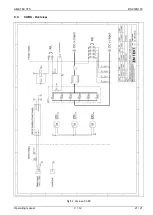
AMETEK CTS
BS 200N100
Operating manual
V 1.12
15 / 21
Electronic Switch for pulses below 400V
Inside the BS 200N100 the electronic switch is built in. A clear determination of a disturbance is possible only if
an electronic switch with reproducible characteristics is used. For the measurement of the pulses under 400V an
electronic switch is recommended (ISO7637-2:2011). The BS200N100 can be used up to 1000V pulses
In order to determine the amplitude and wave shape of a transient, first use the test set-up shown in figure 7.1 for
determine the maximum amplitude of the slower impulses (ms range). In the next procedure use test setup as
shown in figure 7.2 for measure the maximum amplitude of the fast transients.
Switch for voltage impulses higher than 400V special in
s / ns range
The switch affects in particular the characteristics of the fast transient ones substantially. Besides gladly high
amplitudes arise with fast pulses, which can be limited by the protection device of the electrical switch. Therefore,
the standard recommends to use the
original switch
how it is used in the vehicle as switching device for pulses
in
s / ns
range. If such a device is not available, an automotive relay with the following characteristics shall be
used:
-
contact rating,
I
=
30 A, continuous, resistive load;
-
high purity silver contact material;
-
no suppression across relay contact;
-
single/double position contact electrically insulated from the coil circuit;
-
coil with transient suppression.
The switching relay shall be replaced if significant contact degradation occurs.
Resistor Rs
A shunt resistor of 40
shall simulate the dc impedance of other connected consumers in the cable tree.
According to ISO/DIN 7637 when measuring transient overvoltage, a shunt resistor of 40
is required, whereas
when measuring transient overcurrent, a shunt resistor of 2
is required. For this purpose, an external resistor of
2.5
/ 400 W (at 30 V DC) respective 40
must be connected in the test circuit. (Figures 7.1., 7.3 and 7.3.)







































